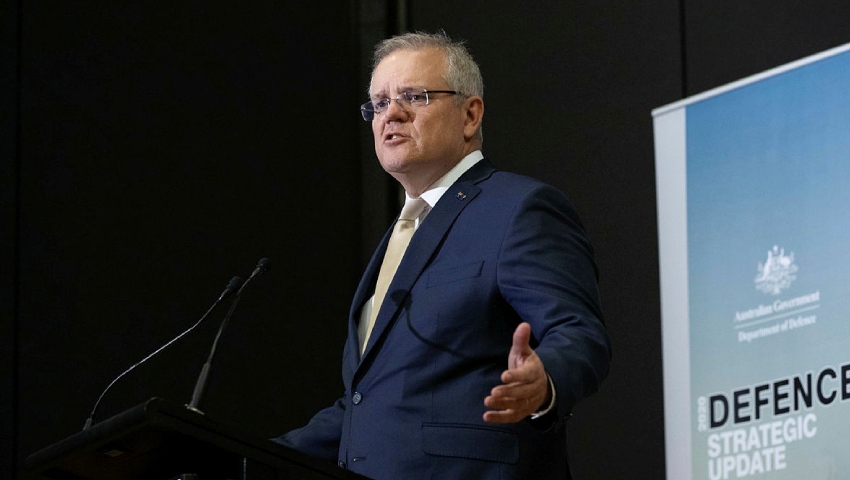Is Canberra’s long-sighted defence strategy failing to uphold the nation’s interests in a rapidly deteriorating regional and global security environment?
The Commonwealth government is accelerating its $250 billion decade-long plan to modernise the Australian Defence Force with next-generation capability across all warfighting domains — land, maritime, air, space, and cyber.
Ahead of the upcoming federal election, expected in May, the Morrison government is building on this strategy, announcing a swathe of new investments in defence capability over the past few weeks.
Last week, Prime Minister Scott Morrison announced $38 billion would be invested in expanding the Australian Defence Force by 30 per cent, increasing the number of personnel by 18,500 to an estimated 80,000 by 2040.
Under the plan, the ADF would command 6,000 more troops than the "critical minimum" recommended by Defence to provide "redundancy and resilience" to cover casualties in the event of an armed conflict.
This is set to represent the largest ADF since the Vietnam War.
This was preceded by a pledge to develop a new naval base on Australia's east coast to support the operation of the Royal Australian Navy’s future nuclear-powered submarines promised under the AUKUS agreement.
Most recently, the government earmarked $4.3 billion for the development of the first large-vessel dry docking facility at Henderson Shipyard in Western Australia.
But will these long-term investments shore up the nation’s defences in a rapidly deteriorating security environment?
Russia’s invasion of Ukraine and Chinese aggression towards Taiwan pose new questions about the ADF’s short-term readiness in the event of a large-scale multinational conflict.
The government recently took steps to deliver interim capability solutions for the ADF, with Prime Minister Morrison confirming RAN bases would host and support the operation of nuclear-powered submarines from the US Navy and Royal Navy under the AUKUS agreement.
Upgrades to HMAS Stirling in Western Australia and the construction of a new east coast naval base are expected to ensure SSNs from the US and UK can remain in Australian waters for “extended periods of time”, enabling them to “perform operations out of Australia”.
Defence has been tasked with commencing studies into the types of infrastructure and services required in Western Australia to support the more frequent presence of SSNs from AUKUS partners, with recommendations expected to be handed down later this year.
Peter Jennings, executive director of ASPI and a former deputy secretary for strategy at the Department of Defence, welcomes the Commonwealth government’s recent announcements but notes the lack of short-term solutions.
He warms a war in our backyard may be imminent, given Chinese President Xi Jinping’s unabashed military objectives.
“In our national security community, it’s thought that the mid-2020s will be the period of maximum risk,” Jennings writes in ASPI’s The Strategist.
“If Xi Jinping is going to attack Taiwan, that’s the time when the People’s Liberation Army may be best placed relative to its opponents for a move against Taipei.”
Jennings also flags the risk of a nuclear confrontation, pointing to the potential for the Russia-Ukraine conflict to directly envelope other nations.
“It will be astonishing if the war remains inside Ukraine’s borders,” he observes.
As such, he claims the bipartisan defence plans of Prime Minister Morrison and Opposition Leader Anthony Albanese “must be completely rethought”.
“One can have too much bipartisanship. On defence, it produces a type of timid complacency,” he writes.
“Defence is not fighting the last war; it’s positioning to fight an imaginary war in 2045. The risk is that we have 24 to 36 months to get ready for a conflict, or to better position to prevent one.”
To address these perceived shortfalls, Jennings offers three solutions.
Firstly, the ASPI analyst suggests Australia support the supply of advanced weapons to Taiwan to avoid being “drawn into a conflict”.
“Out of a fear of provoking Russia, the West failed to arm Ukraine. Let’s not repeat that mistake,” he writes.
“We must rethink our one-China policy, seeking to make Taiwan a very prickly target.”
Next, Jennings adds, the government should commission an independent review of the ADF’s capabilities.
“Doing a new white paper would be pointless because, if Defence drives the process, we will get a revalidation of its efforts over the past 20 years,” he writes.
“The key aim for a review of military capabilities is to determine what can be done to build a stronger deterrence capability inside three or four years.
“The only way to do that is to latch on to current production lines in the US, Britain and Europe. The current bipartisan emphasis on building sovereign defence industry capability is a dangerous myth. Far better to become part of an AUKUS and Quad shared industrial base.”
Finally, Jennings calls on policymakers to leverage technology sharing commitments under the AUKUS partnership to develop a trilateral industry network.
“My understanding is that Defence is resisting any discussion with industry on delivering AUKUS,” he writes.
“The prime minister should convene an industry–AUKUS partnership. We need to harness the private sector of the AUKUS and Quad countries towards delivering new high-technology defence capabilities.”
Jennings concludes: “For its size, Defence delivers significant military capability to government, but it is not designed to handle the scale and speed of current threats.
“We urgently need to tap more lateral and radical thinking about ways to strengthen our deterrence capabilities.”
Get involved with the discussion and let us know your thoughts on Australia’s future role and position in the Indo-Pacific region and what you would like to see from Australia's political leaders in terms of partisan and bipartisan agenda setting in the comments section below, or get in touch with



